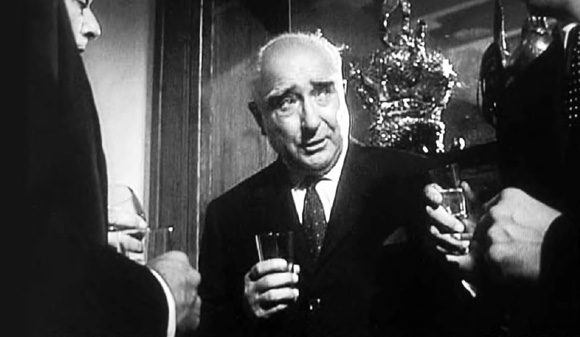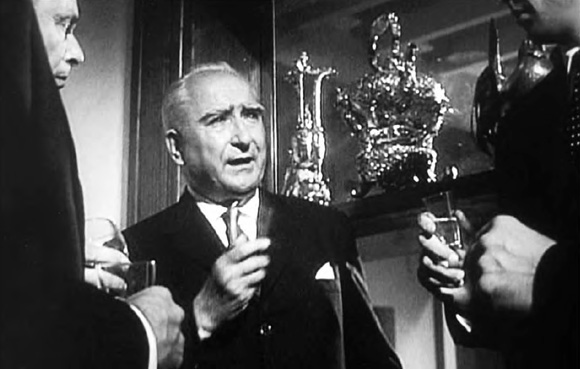Toward the end of Michelangelo Antonioni’s film The Night (1962), there is a conversation between the writer Giovanni Pontano (played by Marcello Mastroianni) and the industrialist Gerardini. The conversation takes place during an all-night party at Gerardini’s estate, a bacchanal of loose play, sexual innuendo, and clothed leaps into a swimming pool. Gerardini wants Pontano to come work for him, to write a history of his company, and then direct the firm’s public relations office. After telling Pontano that his garden already holds over 1,000 rose bushes and a trove of precious statues, the millionaire Gerardini goes on to reflect that his commercial enterprises are themselves works of art. Only he, the great capitalist, can stir up grand design anymore, lasting monuments to the times. While Pontano wants to differ, his words end in affirmation. Yes, he sadly reflects, the free artist is today an anachronism; the times indeed are in the hands of industrialists.
Amazingly, in Italy, in the land whose great family names—the Medici, the Este, the Sforza—are the very symbol of patron, Gerardini’s patronage is to be altogether different. Pontano is a sellout. Why would a successful young writer want to work inside of the bottom-line walls of industry? It was one thing for artists to array themselves under the wings of the great noble or mercantile families during the Renaissance. It would be another thing to do so in the twentieth century, prostituting oneself for the likes of Fiat, General Electric, or Toshiba. In the intervening centuries, the once-steadfast relationship between artist and patron had dissipated within the shapeless social geographies of modernity.
During the Renaissance, the fine arts began their famous journey away from strict religious subject matter and control by artisanal guilds. High above the medieval plateau were forbidden philosophical speculations as well as perceptual delights. Artists began to create works that opened onto pagan myth, secular history, and outright fantasy. Architects designed buildings that elevated their society to the splendors of the ancients.
The very notion of an artist or architect pursuing beauty was extraordinary and only made possible by an alliance with a new group of patrons. These patrons—who included kings, nobles, the mercantile elite, and even popes— derived their wealth more from urban commerce than rural farming. It is no exaggeration to say that the gargantuan palaces, sumptuous pleasure gardens, and canvases of delectable nudes of the Early Modern Era overflowed with the riches of Europe’s growing cities.

Patrons wanted beauty from the arts, but not just for its own sake. Commissions for art and architectural works were also political acts, both a demonstration of the new urban culture’s power to manufacture monumental images and a fencing-in of that urban culture against inevitable winds of reaction. The monopolization of wealth and power in the hands of a few—the new urban patrons of the arts—was steadied and ennobled by the persuasive powers of the arts and the heroic imaging of artist and architect. For several centuries, patron and artist would be linked by the world they sought to create, rationalize, and control. Nothing lasts forever. During the second half of the nineteenth century, amid the pandemonium of industrialization, the one-to-one alliance of patron and artist began to crumble. By this time, the Early Modern culture of pleasure and beauty had come under assault by the proliferating gradients of profit and utility. Classical regularity and natural imitation were undone in time’s changes, stacked in museums and expounded in universities. Elsewhere the old world was ground to pulp under the oiled wheels of economic and technological change.
Patrons and artists were changing. The class of patrons became much larger and less unified, because industrial capital created huge quantities of new wealth and conditions for fluid social mobility. Added to the nobility and mercantile middle class were the nouveau riche of industry and the new representatives of middle-class democracy. When it came to matters of art and architecture, the newly mixed masters of business and politics began pointing their sights toward antagonistic cultural galaxies.
Shadows were simultaneously crossing the space of art and architecture. Beginning with such figures as the painter Eduard Manet and the architect Henri Labrouste, artists and architects began to question the values of their patrons and of the academies of design and salons of exhibition supported by those patrons. In times of severe social dislocation, visual art produced in celebration of the established order could no longer go unquestioned. How could artists represent the tens of thousands of peasants flocking to new factory jobs in the cities through their customary venues of mythological or historical paintings? How could architects design buildings to house and educate those masses behind facades carrying the weighty language of classical pilasters and pediments? Furthermore, would art that supported the social order also bristle with that order’s flaws? Would tradition-bound architecture capture the furious, unbalancing movement of its new world?
From the 1860s to the 1960s, the great story in art and architecture was the rise of the avant-garde. The avant-garde signaled an end to the cozy relationship between artists and patrons that had been built up since the Renaissance. Avant-garde art and architecture were revolutionary. They sought to overturn or at least destabilize dominant artistic practices and institutions. Self-consciously ahead of its times, the avant-garde was caught up with notions like progress and originality. To be progressive meant not accepting the conventions of the times, and, instead, striving for higher truths. To be original was to explore aspects of reality suppressed by societal order and its codes of meaning.
If avant-garde artists and architects saw themselves as leaders of the modern pack, their identity came from standing apart from the social conventions and business economy that had produced them. Opposing social codes and perceptual protocol meant separating modernism, as the creation of a new world led by artists, from modernity, the social world as it developed according to the forces of bourgeois capital.
Accordingly, the avant-gardes broke ties with both imitation of the old order and harmonious relationships with patrons of the old order. They explored form- and space-making in ideal, utopian worlds. Their manifestoes paid homage to excess and marginality. The avant-gardes also frequently identified as bohemians—as outsiders, wanderers, yet possessed of an integrity of character lost to the unreflective participants of industrial modernity. Adapted from observations of gypsies in the Czech lands, the identity of the bohemian was patently anti-patron. Interestingly, the identity of the bohemian has proven to be as durable as that of Avant-garde. All through the twentieth century, bohemia would migrate within an astoundingly vast array of social identities, inclusive of folk hoboes, jazz musicians, beatniks, hippies, punks, and, of course, all types of artists.
While architects wore less outrageous bohemian dress and were less hostile to the established social order than painters or sculptors, their relation to modernity was also one of critical utopianism. Through such epochal figures as Le Corbusier and Frank Lloyd Wright, architects claimed the skills and insights necessary to resolve the great contradictions of industrial society. To be sure, architects, more than artists, were dependent upon the commissions of patrons to realize their projects. But, by and large, they worked with patrons—individuals or municipal governments—who also saw themselves as oppositional and enlightened to the need for radical social reforms. The great modernist utopias from the 1920s to 1960s were conceived as expressions of a world where patrons followed the lead of architects and where artists implicitly led industrialists by the nose.
What are we to make, then, of Giovanni Pontano’s surrender to Gerardini in 1962? Hadn’t architects created impeccable high-rise cities set on green terraces and enveloped by smooth-flowing traffic? Hadn’t artists recaptured the primordial beginnings of form- and space-creation? Wasn’t world culture finally routed along the prophetic arc of avant-garde insight?
Alas, a host of factors like National Socialism, the Stalinist Gulag, Hiroshima, Dien Bien Phu, urban renewal, and worldwide Coca Cola had intervened. The dogmatic ideologies that had brought the avant-garde to life in the first place became its own worst enemies. Avant-garde modernism was undone by its success and its ensuing association with other, more extreme rational systems. In other scenes of The Night, especially Lidia Pontano’s alienating walk through the concrete and glass jungle that had become modern Milan, Antonioni astutely anticipated the upcoming, massive critique of modernism.
Between the early-1960s and mid-1970s, the modernist project was abandoned. After the emergence of Independent Group in Great Britain, Pop Art in the United States, and postmodernism just about everywhere, the modernist avant-garde became historical. The art critic Clement Greenberg’s category-bound modernism was defied in gallery shows of loose interbreeding. Architectural students stopped reading Sigfried Giedion’s high-limbed Space, Time, and Architecture and plunged into a junkyard of chrome-plated columns and dancing cupolas. Mies became a bore. Only a few years after Jackson Pollock’s adventure into self-realization, Andy Warhol dissolved the artist’s heroic identity within the vulgarities of money, advertising, and social status.
How could the projects of avant-garde modernism, over a century in the making, come crashing down so quickly? How could the status of architect (and artist) as superior partner in a marriage with their patrons have had such a short life span?
Click here for “The Architecture of Patronage, Part II: the Rise of the Anti-Patron.”
Author Mitchell Schwarzer, PhD, is the author of German Architectural Theory (1995), Zoomscape: Architecture in Motion and Media (2004), Architecture of the San Francisco Bay Area: History and Guide (2007), and the upcoming Home Egonomics: America’s Obsession with Real Estate. He is Chair of the Department of Visual Studies at California College of the Arts.
Originally published 2nd quarter 2007 in arcCA 07.1, “Patronage.”








